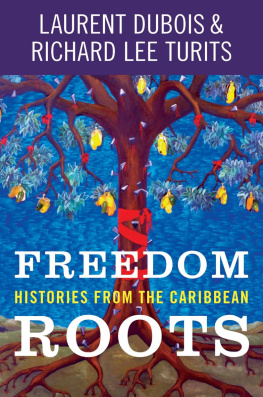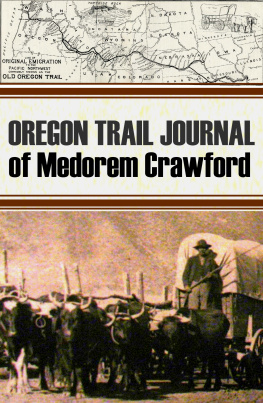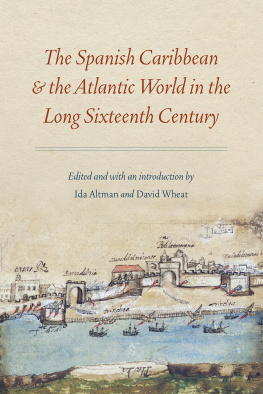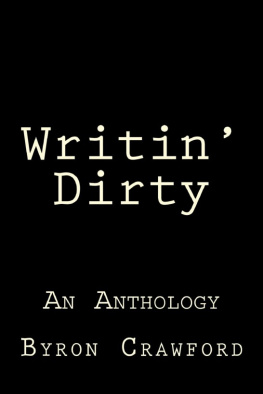The Last Turtlemen of the Caribbean
FLOWS, MIGRATIONS, AND EXCHANGES
Mart A. Stewart and Harriet Ritvo, editors
The Flows, Migrations, and Exchanges series publishes new works of environmental history that explore the cross-border movements of organisms and materials that have shaped the modern world, as well as the varied human attempts to understand, regulate, and manage these movements.
The Last Turtlemen of the Caribbean
Waterscapes of Labor, Conservation, and Boundary Making
Sharika D. Crawford
The University of North Carolina PressCHAPEL HILL
This book was published with the assistance of the Wells Fargo Fund for Excellence of the University of North Carolina Press.
2020 The University of North Carolina Press
All rights reserved
Set in Merope Basic by Westchester Publishing Services
Manufactured in the United States of America
The University of North Carolina Press has been a member of the Green Press Initiative since 2003.
Library of Congress Cataloging-in-Publication Data
Names: Crawford, Sharika D., author.
Title: The last turtlemen of the Caribbean : waterscapes of labor, conservation, and boundary making / Sharika D. Crawford.
Other titles: Flows, migrations, and exchanges.
Description: Chapel Hill : University of North Carolina Press, [2020] | Series: Flows, migrations, and exchanges | Includes bibliographical references and index.
Identifiers: LCCN 2020007548 | ISBN 9781469660202 (cloth: alk. paper) | ISBN 9781469660219 (paperback: alk. paper) | ISBN 9781469660226 (ebook)
Subjects: LCSH: Sea turtle fisheriesCayman IslandsHistory19th century. | Sea turtle fisheriesCayman IslandsHistory20th century. | Sea turtle fisheriesPolitical aspectsCaribbean Area. | Maritime boundariesCaribbean AreaHistory. | Sea turtlesConservationCaribbean Area.
Classification: LCC SH399.T9 C73 2020 | DDC 333.957928097292/1dc23
LC record available at https://lccn.loc.gov/2020007548
Cover illustrations: Background, clear blue water ( iStock.com/kaisorn); foreground, turtlemen in boat (courtesy of the Monroe County Public Library and the Key West Art and Historical Society).
For the men in my life,
Kwesi, Yoshua, and Kalev
The Turtlers ABC
BY HILARY THOMPSON
A is for Anchor the Cayman boys weigh,
B is for Bobell that steers them away,
C is for Compass that always points right,
D is for Danger we fear in the night.
[Chorus:] So wet and tired and hungry are we,
Theres no one who suffers like a turtler on sea.
E is for Ensign we always fly high,
F is for Farewell that makes all the girls cry,
G is for Galley, our breads are secure,
H is for Halyard that makes our hands sore.
[Chorus]
I is for Interest the turtle to procure,
J is for Judgment we use on our oars,
K is for Kettle we boil our tea,
L is for Lookout we keep on our lee.
[Chorus]
M is for Mainsail we often times reef,
N is for North wind that blows very bleak,
O is for Oars we pull with our might,
P is for Poverty we seen in plain sight.
[Chorus]
Q is for Quadrant our hearts all cheer,
R is for Rain that never goes clear,
S is for Staysail we haul quickly down,
T is for Tea we often pass round.
[Chorus]
U is for Union Jack we fly up and down,
V is for Vessel thats now in the Sound,
W is for Waiting for North Wind to blow,
And off to Jamaica the whole fleet will go.
X,Y,Z, now will end you our song,
See how sweetly and smoothly it all goes along!
[Chorus repeated twice.]
Contents
Figures, Maps, and Table
FIGURES
MAPS
TABLE
190545
Acknowledgments
Many people and institutions have supported me on this journey of completing the manuscript. Several institutions generously funded the research and writing presented in this book in the form of the following fellowships and grants: National Endowment for the Humanities (NEH) Summer Stipend, NEH Summer Seminar Grant, United States Naval Academy (USNA) Recognition Grants, USNA McMullen Sea Power Fellowship, CIES Fulbright U.S. Scholar Grant, University of Florida Center for Latin American Studies Library Travel Grant, and American Philosophical Society Franklin Research Grant. This financial support would have been impossible without the support of Lara Putnam, Jane Landers, George Reid Andrews, Richard Abels, Rick Ruth, Silvia Peart, Camilo Quintero, Claudia Leal, Alejandra Boza Villareal, Jason McGraw, Gene Smith, Reza Malek-Madani, and Jean Schroeder, who wrote letters of support and affiliation, and shepherded me through the grant application process.
Like the turtlemen, I traveled around the greater Caribbean to find sources on turtles and the turtle hunters. The staff and personnel at several archives and libraries assisted me in finding critical source material for this book. I am grateful to the staff at the following institutions: Archivo General de la Nacin de Colombia, Archivo Nacional de Costa Rica, Banco de la Repblica de Colombia Centro de Documentacin, Biblioteca Lus ngel Arango Sala de Libros y Manuscritos, Cayman Islands National Archive, United Kingdom National Archive, United States National Archive College Park, and University of Florida Smathers Library Special Collection of Latin American Studies. Special thanks go to Juan Igancio Arboleda, Charisse Morrison, Tricia Bodden, Mirta Yaneth Daz, Brenda Ebanks, Paul Losch, the late Carol Mascarenhas, Peggy McBride, Terry Phillips, Daniela Samur, and Mauricio Tovar.
A number of people generously shared their curiosity, enthusiasm, and expertise with me over the years or simply extended great friendship or kindness to me during the process of researching and writing this book. During the fall of 2015, I spent a semester of my yearlong sabbatical conducting research in Colombia. Many thanks to Claudia Leal, Shawn Van Ausdal, Muriel Laurent, Ana Maria Otero, Catalina Merchn, Marta Herrera, Catalina Muoz, Camilo Quntero, Luis Snchez, Pilar Cadena, Marixa Lasso, Monica del Valle, Ral Roman Romero, Ana Isabel Mrquez, Mirta Yaneth Daz Velsquez, Felipe Laverde, Shalinda Martnez, Penn Dale Humphries, Angie Paula Vargas, Oscar Montoya, Arnaldo Meneses, and Violeta Barrios. I also spent five weeks reading, researching, and learning about the American Maritime Commons with a fabulous group of scholars at the Munson Institute in Mystic Seaport in 2016. I owe a special thanks to Glen Gordinier, Eric Paul Roorda, Bina Arch, Diane Boucher, Michelle Zacks, Michelle Moon, Steven Pitt, Ramona Olvera, Lisa Vandenbosche, Timothy Walker, Matthew Booker, and Helen Rowzadowski. In Costa Rica, I extend a heartfelt abrazo a mi colega Alejandra Boza Villareal and her husband, Scott, who opened their home to me while visiting San Jos. I also thank Rina Cceres, Leidy Alpizar, and Walter Anderson at the Universidad de Costa Rica for their interest in my scholarship and arranging a research talk at the Puerto Limn branch.
At my home institution in Annapolis, my colleagues Rick Ruth, Lee Pennington, Don Wallace, Matthew Dziennik, and Brad Barrett have all commented on early drafts, full chapters, and countless grant proposals over the past five years. It is a better book because of the high caliber of colleagues who surround me. Finally, Emily Wakild, John Soluri, Jason Smith, and Bina Arch graciously commented on book proposals, conference papers, and book chapters at various stages in this process. While I dare not call myself an environmental historian, these environmental historians have done much to steer me toward greater engagement with scholarly conversations about nature and the marine environment. I also thank Kristy Johnson and Kate Epstein for judiciously copyediting the manuscript.










![Chris Crawford [Chris Crawford] - Chris Crawford on Game Design](/uploads/posts/book/119438/thumbs/chris-crawford-chris-crawford-chris-crawford-on.jpg)
